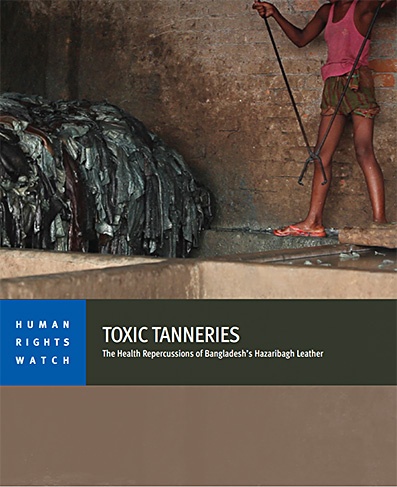18 October, 2012HRW releases an extremely alarming report on leather tanneries poisoning workers and damaging local communities in Hazaribagh, Bangladesh.
The HRW report “Toxic Tanneries: The Health Repercussions of Bangladesh’s Hazaribagh Leather,” documents in a very detailed manner occupational health and safety hazards suffered by tannery workers and local communities exposed to chemicals used in some 150 tanneries of Hazaribagh, the old Dhaka industrial area, one of the largest leather producing zones of Bangladesh.
The hazards include skin diseases and respiratory illnesses caused by exposure to tanning chemicals, but also limb amputations caused by accidents in dangerous tannery machinery. The report documents facts of child labour used in tanneries, where children work long hours with no personal protection equipment often resulting in accidents, also salaries are considerably lower than paid to adults performing similar type of work.
Residents of Hazaribagh slums complain of illnesses such as fevers, skin diseases, respiratory problems, and diarrhoea, caused by the extreme tannery pollution of air, water and soil. According to the government estimates some 21,000 cubic meters of untreated effluent is released each day in Hazaribagh.
Apart from documenting the hazards the report also gives a clear list of recommendations on how the situation can be changed including primarily the urgent necessity to address the issue by the authorities. So far even the existing national environmental laws are not respected by tannery owners, who find it unnecessary to make even minor modification of the production process or use the chemicals that are slightly more expensive but cause less damage to the workers and environment.
A complex approach should be applied including overhaul of labour inspectorate and addressing the issue through the final buyers. According to the report from June 2011 to July 2012 Bangladesh exported around $663 million of leather and leather goods, including footwear. The leather is exported to some 70 countries throughout the world, but principally China, South Korea, Japan, Italy, Germany, Spain, and the United States.
The report does not state names of concrete buyers but believes that “companies that buy leather produced in Hazaribagh should be aware that businesses of all types have a responsibility to respect human rights, including workers’ rights”. Human Rights Watch considers that “systemic action across the Hazaribagh leather tanneries offers the best hope for remedying the health and human rights conditions identified in this report”.


